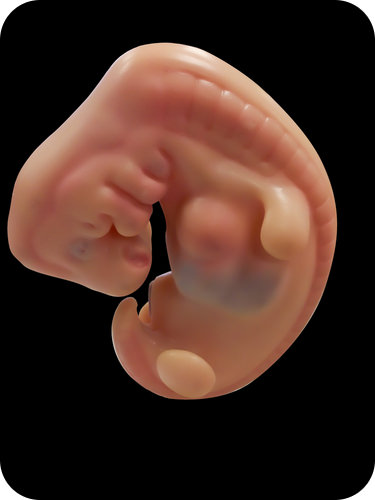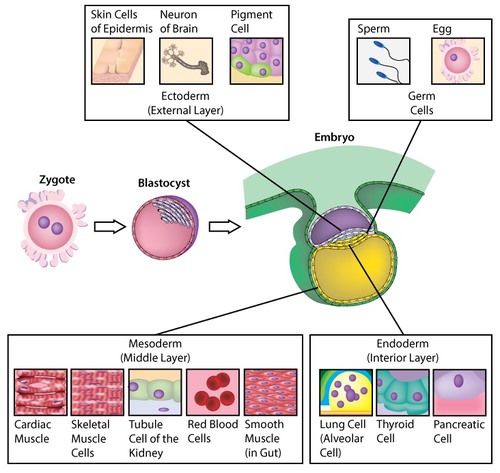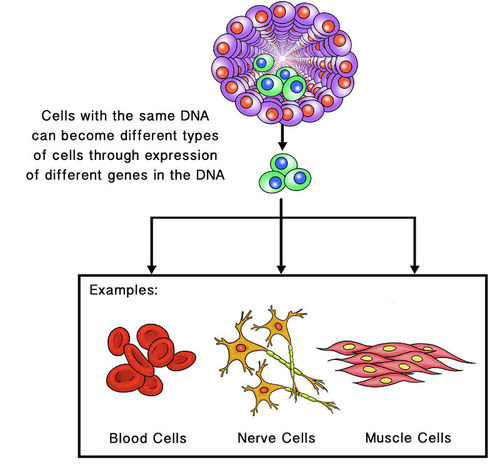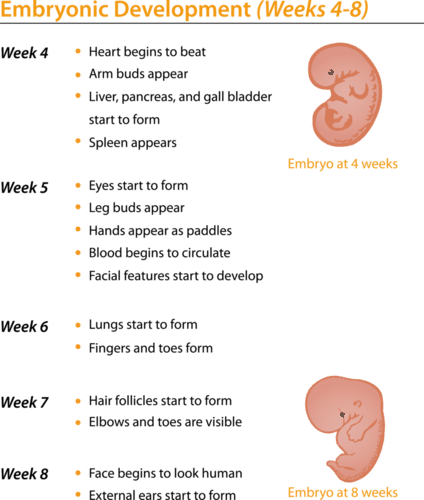13.62: Embryo Growth
- Page ID
- 13533

At one time, did we really all look alike?
We all start as a single cell and soon grow into an embryo. Notice the remarkable details beginning to form. The eyes, backbone, and limb buds are obvious. Think about the amazing complexity that must be going on inside the embryo, and the tremendous amount of growth and development still to come. So, yes, at one time we all looked similar.
Growth and Development of the Embryo
After implantation occurs, the blastocyst is called an embryo. The embryonic stage lasts through the eighth week following fertilization. During this time, the embryo grows in size and becomes more complex. It develops specialized cells and tissues and starts to form most organs.
Formation of Cell Layers
During the second week after fertilization, cells in the embryo migrate to form three distinct cell layers, called the ectoderm, mesoderm, and endoderm. Each layer will soon develop into different types of cells and tissues, as shown in Figure below.
 Cell Layers of the Embryo. The migration of cells into three layers occurs in the 2-week-old embryo. What organs eventually develop from the ectoderm cell layer? Which cell layer develops into muscle tissues?
Cell Layers of the Embryo. The migration of cells into three layers occurs in the 2-week-old embryo. What organs eventually develop from the ectoderm cell layer? Which cell layer develops into muscle tissues?Differentiation of Cells
A zygote is a single cell. How does a single cell develop into many different types of cells? During the third week after fertilization, the embryo begins to undergo cellular differentiation. Differentiation is the process by which unspecialized cells become specialized. As illustrated in Figure below, differentiation occurs as certain genes are expressed ("switched on") while other genes are switched off. Because of this process, cells develop unique structures and abilities that suit them for their specialized functions.
 Cellular differentiation occurs in the 3-week-old embryo.
Cellular differentiation occurs in the 3-week-old embryo.Organ Formation
After cells differentiate, all the major organs begin to form during the remaining weeks of embryonic development. A few of the developments that occur in the embryo during weeks 4 through 8 are listed in Figure below. As the embryo develops, it also grows in size. By the eighth week of development, the embryo is about 30 millimeters (just over 1 inch) in length. It may also have begun to move.
 Embryonic Development (Weeks 4–8). Most organs develop in the embryo during weeks 4 through 8. If the embryo is exposed to toxins during this period, the effects are likely to be very damaging. Can you explain why? (Note: the drawings of the embryos are not to scale.)
Embryonic Development (Weeks 4–8). Most organs develop in the embryo during weeks 4 through 8. If the embryo is exposed to toxins during this period, the effects are likely to be very damaging. Can you explain why? (Note: the drawings of the embryos are not to scale.)Summary
- The embryonic stage begins with implantation.
- An embryo forms three distinct cell layers, and each layer develops into different types of cells and organs.
Review
- Explain how the embryo forms specialized cells.
- What organs eventually develop from the ectoderm cell layer?
- Which cell layer develops into muscle tissues?
- If the embryo is exposed to toxins during weeks 4 through 8, the effects are likely to be very damaging. Can you explain why?
| Image | Reference | Attributions |
 |
[Figure 1] | Credit: CK-12 Foundation, using embryo illustrations copyright lelik759, 2014 Source: http://www.shutterstock.com License: Embryo illustrations used under license from Shutterstock.com |
 |
[Figure 2] | Credit: Zachary Wilson Source: CK-12 Foundation License: CC BY-NC 3.0 |
 |
[Figure 3] | Credit: Laura Guerin Source: CK-12 Foundation License: CC BY-NC 3.0 |
 |
[Figure 4] | Credit: CK-12 Foundation, using embryo illustrations copyright lelik759, 2014 Source: http://www.shutterstock.com License: Embryo illustrations used under license from Shutterstock.com |

